One of the best unsung tools ecommerce retailers have at their disposal is their own data.
Think about it: You have data about your products. Your sales. Your web traffic and views. How often people click on each product you offer. How often they add it to their cart. How often they make it to checkout. How often they actually make the purchase. And how often they make it to each of those steps, depending on what channel they used to find your site in the first place.
All that data can be harnessed to help you boost sales — and your bottom line. But are you taking full advantage of it? Many retailers aren’t.
The key to making the best use of all that data is in aggregating and analysing it. And, because that can be a huge job for an ecommerce retailer with a lot of products on offer, harnessing the power of automation to make the whole process faster and simpler.
There’s a learning curve, but with the right tools, any online retailer can become an expert at product data aggregation and analysis. Let’s get started.
What Is Data Aggregation?
If you’re brand new to using data to increase your online sales, you might be wondering: What is data aggregation?
Don’t worry — it’s pretty straightforward. Aggregation is the process of gathering data from different sources and presenting it in a simple, summarized format that makes it easier to analyze.
Why would retailers want or need to aggregate their data?
Well, like we’ve already said, you probably have a lot of it. And if your business is omnichannel, you probably have data coming from a lot of different sources. That means, to get the best use of all that data, it will need to be aggregated before you can analyze it.

Aggregating your product data allows you to see the big picture of your entire customer journey, with all its touchpoints and channels. That allows you to better understand your customers, so you can better cater to their needs and convert them.
How to Get Started: Product Data Aggregation Best Practices
While it may be theoretically possible to aggregate and analyze an entire business’ product data the old-fashioned way, by putting pen to paper (or cursor to spreadsheet), don’t do that. There are a ton of great tools available that are designed to make data aggregation and analysis as simple as possible.

When looking for the right tool for your business, keep this in mind: It needs to accomplish two core functionalities.
- Tracking customer data, by capturing visits, events, and actions.
- Analyzing data, by creating dashboards and reports that help you see valuable insights about your customers and your business.
But a great data platform will do even more than that. There are some other key features you should be on the lookout for when choosing a platform. Namely, whatever platform you ultimately choose should be able to:
- Identify all data sources (your entire product catalog and all your current sales and marketing channels), and bring them together.
- Find any external data sources, and then match them to internal sources.
- Analyze aggregated data in an easy-to-read format, with a dashboard that allows you to sort data in different ways to explore different insights.
- Report data based on KPIs that you set for your business.
If this is sounding like a lot of work, you’re not wrong. However, modern tools take a lot of the manual labor out of the process of aggregating and analyzing product data. They key is finding a tool with all the functionality we’ve listed above, but that can also help you automate the entire process of aggregating product data for analysis.
Make Data Aggregation Simple by Automating the Process
Many retailers, especially smaller ones, might be thinking, “Why should I find a tool that automates data aggregation? I can do this manually and save a few bucks.”
You can, but that doesn’t necessarily mean you should.
Manual data aggregation is an outdated practice in 2020, but it can also come with tangible consequences for your business, including:
- Slower time-to-market, which loses you sales and decreases your business’s agility and flexibility for expanding to new channels.
- Expensive overhead when you have to pay for hours and hours of work spent doing constant, rote aggregation tasks that you could automate, instead.
- Inability to scale. Sure, you can manually aggregate your data now, while your business is small. But what about as you grow? Don’t you want to be ahead of the curve and ready to scale as soon as your business is ready to? You need to automate.
In the omnichannel world we live in, using technology to its full potential and automating data aggregation will only become more important. As new channels and digital touchpoints arise all the time, the customer journey is getting more and more complex. Even if you don’t think you need it yet, automation is a necessary part of a data platform that can grow with your business.
Ecommerce Retailers’ Secret Weapon for Data Aggregation: PIM
So you know what your data platform needs to be able to do (including automating aggregation of data). Now it’s time to introduce the one tool that’s like a secret weapon for ecommerce retailers who want to make their product data work for them: Product information management (PIM) software.
The right PIM solution can deliver a long list of features that will benefit your business, including a centralized place to store all the many pieces of product data a growing ecommerce business needs to keep track of. It creates a single source of truth, where various people and teams across your organization can access — and update — product data and know that it’s always the most accurate, up-to-date version of that data that’s available across the organization. And a PIM solution can push that data to websites, apps, social media, and other marketing and sales channels you use.

But the best PIM software will do double-duty as a place where you organize product information, as well as a place where you aggregate product data and analyze it. It should provide such integral ecommerce analytics as:
- Product impressions
- Product listing views
- Product page views
- Product funnel metrics
- Purchase data
- Buyer journey data
- Product groupings and other flexible segmentation of data
- Multi-channel dashboards
- Cross-domain tracking
In other words, the best PIM should be a powerful tool that delivers value to your organization in every way that you use product information and data.
That’s Not All PIM Can Do
PIM software does more than just aggregate and analyze product data for your business, which is why it’s such an important investment for ecommerce retailers to make.
The PIM market is exploding as more and more top retailers adopt this type of software. PIM adopters consistently see improved sales, operating margins, market reach, customer satisfaction in just 2 years, meaning this is a tool with a measurable ROI that’s great for your business.
Want to learn more about the advantages PIM users get in a competitive ecommerce landscape — and how to choose the right PIM to help your business succeed? Download our free ebook today.
Frequently Asked Questions




![The Evolution of Ecommerce [10-50 Years] [Timeline]](https://www.plytix.com/hubfs/00_The%20Evolution%20of%20Ecommerce-Retail_hero.png)
